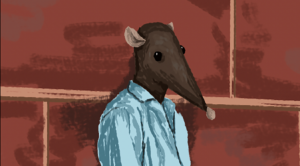While Georgetown University may have just introduced its new, living, Jack the Bulldog, the Hilltop’s unofficial mascot also remains alive and well. Maybe it’s time we abandon our Hoya moniker and adopt a new mascot: the Georgetown Rodents.
Georgetown’s rats and mice are infamous, with their presence serving as an annoyance and common grievance for students. It’s not unusual to see multiple rats scurry across the sidewalks on a late-night walk back from Lau or a rat carcass on the street after it met its fate at the wheels of a car.
While rats and mice may scurry away at the sight of a human, their numerous impacts on campus, from causing physical illness and student mental health concerns to hurting our spot in national college rankings, are proving rodents to be a pest to Georgetown’s success.
Rodents are not just a campus issue. Local media has covered rats found in local institutions like Moby-Dick, the Waterfront, and Wisemiller’s Deli. John Wiebenson, Vice President of operations of the Georgetown Business Improvement District (BID), explained that rats and mice remain an issue across the Georgetown community.
“We’re not even experiencing spillover from the university. We have enough rodents of our own,” Wiebenson said. “We’re working with D.C. Public Health to educate residents and businesses on how to prevent rodent activity.”
While the BID takes active measures to prevent rodent infestations, the university is much more lax in its approach. Georgetown University’s main reactionary measure is outsourcing rodent control to Terminix, a Memphis-based contractor that serves GU infrequently and does so with a one-size-fits-all approach. According to Joe Massaua (SFS ’25), Commissioner of D.C. 2E04, what Georgetown needs isn’t a bandaid on the problem, but rather a comprehensive rodent mitigation solution.
“The BID works to provide rodent control, including active measures such as going in with dry ice or carbon monoxide and actually taking out the rat burrows,” Massaua said. “On campus, a hired contractor called Terminix comes when called and they’ll put up these little black boxes that sometimes aren’t even set up correctly. These boxes aren’t active measures, just traps, and rats can get out of them.”
Georgetown must also address systemic issues related to waste management that would mitigate rodent infestation on campus. “There are some pretty severe violations. I mean, there are a ton of dumpsters that don’t even have lids on them, which is a serious violation of the waste management code,” Massaua said.
Georgetown isn’t the only D.C. university with rodent issues. In 2021, student protests and sit-ins at Howard University called on administrators to address facilities issues, including rats in dorms. A decade prior, in 2012, a lawsuit filed by 19 Howard students alleged they had been negatively impacted by rats and mold in Howard facilities.
In 2018, American University’s Megabytes Cafe was forced to close after students captured video of a rat inside the restaurant’s kitchen. Dubbed “Wonk Rat,” the creature became an American University icon, with its own merch line, Instagram, and Twitter accounts. George Washington University also has an Instagram dedicated to its rodent residents (@gwurats).
“We work with all of the area universities,” Gerard Brown, D.C. Manager of Rodent Control, said. “I was at Georgetown in September at a meeting with people about rats.”
Georgetown’s rat issues sound all too familiar to students of other D.C. universities. Not only are there rodents across campus, but Georgetown students also experience mice inside their dorm rooms.
“One time, I left a sealed bag of popcorn out and a mouse somehow got onto my desk, ripped it open, and ate it,” Ally Latsilnik (CAS ’27), a first-year student living in Darnall Hall, said. “A lot of people I know have rat or mouse traps. And they also put towels under the AC units to stop [mice] from traveling inside them.”
Maria Halter (CAS ’27) also didn’t realize there were mice in her Darnall room until she noticed droppings collecting in different corners of her room. After cleaning the droppings, Halter became uncharacteristically sick.
“I realized ‘I think I’ve been vacuuming mouse poop’,” Halter said. “Then the second night that I saw it, I got really, really sick. And I was freaking out because I hadn’t gotten that sick in years, but I had fever, chills, and body aches out of nowhere.”
Halter had to call GERMS to assist her because she was too sick to move. While GERMS couldn’t confirm that the mice made Halter sick, her online research led her to believe that the mouse droppings may have been behind her illness. Mouse and rat droppings are known to cause arenaviruses and salmonella, along with several other illnesses and rare diseases.
After Halter recovered, she put in a work order asking facilities to install mouse traps. While they promised to be there the next morning, it took three days for Halter’s room to be equipped.
“I had to basically leave my room,” Halter said. “I was freaked out and so sick and [facilities] couldn’t do anything about it.” Halter stayed in friends’ rooms for nearly a week, waiting. However, the traps never captured any mice.
Halter’s neighbor in Darnall, Elizabeth Martin (CAS ’27), also had mouse issues. While she was prepared by upperclassmen for what she would face, she didn’t think rodents would be a real concern.
“[Darnall has] a reputation for having a rat and mice problem, but I was like, ‘Oh, they’re probably just being overdramatic, like how could facilities let there just be mice running rampant?’” Martin said. “But in the last month we’ve had three mice. It makes you not want to be in your dorm [where] I feel like you’re supposed to be in a place where you can come back and relax, but instead I spend a lot of time in the common room.”
Not only are current Georgetown students overwhelmed by the presence of rodents on campus, but those outside the community are becoming aware of the university’s problem as well. Online forums for parents and potential students are filled with warnings about Georgetown’s rodent issues. On Let’s Run, a forum for parents of potential track and field commits, a parent detailed their child’s experience during a visit to Georgetown.
“My kid went on an official [visit] last year and didn’t see rats but did see mice in the dorm,” the anonymous parent said. “It was pretty run down compared to dorms at other schools that we visited.”
In response, another parent joked, “I bet the basketball coach makes ~5 million, while the school’s infrastructure crumbles.” Ironically, FOX Sports estimates that new head coach Ed Cooley’s contract is worth around $5-6 million per year. Meanwhile, our sources have estimated that Georgetown pays Terminix around $1 million per year to cover all campus rodent control, extermination, traps, etc.
Georgetown’s rodents have joined the conversation on the Reddit page r/ApplyingToCollege, which has over one million members and describes itself as the “premier forum for college admissions questions.” When an anonymous prospective student posted to the page to celebrate getting financial aid from Georgetown, another student responded, “Spend every penny you saved on rat traps.”
In another post, a student voiced their hesitation to commit to Georgetown because of the rat population.
“I’m scared,” the prospective student confessed. “I kinda want to commit to Georgetown… but rats are a HUGE deal breaker.”
Rodent issues are also hurting Georgetown’s college ranking. While Georgetown received A+ ratings in academics, diversity, professors, value, and student life from online college ranking site Niche, the school’s lowest ranking was a C in dorms. 70% of Niche’s dorm ranking is determined by reviews from members of the community. With many low reviews citing rodents, it’s clear that cleaning up rat issues could boost rankings.
With rodents impacting current students, prospective students, and school’s rankings, a crisis seems to be brewing on the Hilltop. When asked for a comment, a university spokesperson shared the following statement.
“The University monitors for and responds to reports of mice, rats and other rodents on campus. The Department of Planning and Facilities Management coordinates pest control inspections on campus. Members of the university community can report rodents on campus by submitting a service request at facilities.georgetown.edu.”
While rodents may not be the official mascot of Georgetown, they’re certainly on their way to becoming a hallmark of the Hoya experience. For new and returning students, some advice from user u/blu_gatorade, posted to r/ApplyingToCollege seems apropos:“Better start watching Ratatouille so you’re prepared for having rats in your food. And your bedroom. And your toilet.”






Georgetown treated its COVID response like the US Marshall plan. Time to take same level of seriousness to rat and mouse problem.
hi